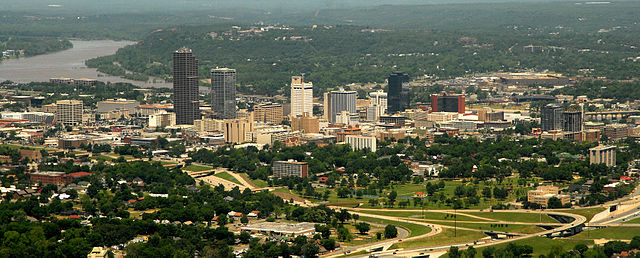When you’re planning a trip to Arkansas or considering calling Little Rock home, understanding the local weather patterns becomes absolutely crucial. Have you ever wondered what makes Little Rock’s climate tick? The capital city of Arkansas experiences a fascinating blend of weather patterns that can surprise even the most seasoned meteorology enthusiasts.
Little Rock’s weather tells a story of contrasts – from sweltering summers that make you appreciate every air-conditioned space to surprisingly mild winters that occasionally throw curveballs. This comprehensive guide will walk you through everything you need to know about Little Rock’s climate, helping you prepare for whatever Mother Nature decides to serve up.
Understanding Little Rock’s Climate Zone
Little Rock sits comfortably within the humid subtropical climate zone, which sounds fancy but essentially means you’re getting a healthy dose of humidity along with your seasonal temperature variations. Think of it like living in nature’s own sauna for part of the year, followed by surprisingly pleasant relief periods.
Humid Subtropical Climate Characteristics
The humid subtropical classification isn’t just meteorological jargon – it’s your roadmap to understanding what you’re dealing with year-round. This climate type brings hot, humid summers and mild winters, with precipitation spread fairly evenly throughout the year. It’s like getting four distinct seasons, but with humidity as your constant companion during the warmer months.
What makes this climate particularly interesting is its unpredictability. You might experience a 70-degree day in January, followed by a sudden cold snap that drops temperatures into the 20s. This variability keeps locals on their toes and makes weather watching a genuine hobby for many residents.
Geographic Influences on Weather Patterns
Little Rock’s position in central Arkansas creates a unique meteorological playground. The city sits at approximately 335 feet above sea level, nestled in the Arkansas River Valley. This geographic positioning acts like a natural amphitheater for weather systems moving across the region.
The Ouachita Mountains to the southwest and the Ozark Mountains to the northwest create interesting weather dynamics. These mountain ranges can deflect, channel, or intensify weather systems, creating microclimates that make Little Rock’s weather fascinatingly complex. It’s like having nature’s own weather modification system right in your backyard.
Seasonal Weather Breakdown in Little Rock

Understanding Little Rock’s seasons is like learning the rhythm of a complex musical piece – each movement has its own character, tempo, and surprises. Let’s dive into what each season brings to the table.
Spring Weather (March-May)
Spring in Little Rock is arguably the most dramatic season, weather-wise. It’s when the atmosphere seems to wake up from winter’s slumber and decides to flex its muscles. This season brings the promise of warmth alongside the threat of severe weather.
Temperature Ranges and Precipitation
March typically starts cool, with average highs in the mid-60s, but by May, you’re looking at comfortable highs in the upper 70s to low 80s. Nighttime temperatures during spring range from the 40s in early March to the 60s by late May. It’s like watching nature gradually turn up the thermostat.
Spring precipitation averages around 4-5 inches per month, but don’t let that average fool you. You might get three weeks of beautiful weather followed by a week of daily thunderstorms. The rain often comes in bursts, making spring both a blessing for gardens and a challenge for outdoor event planners.
Severe Weather Considerations
Here’s where spring in Little Rock gets serious. The season brings the highest probability of severe weather, including tornadoes, large hail, and damaging winds. Peak tornado season typically runs from April through June, with May being the most active month.
Why does spring bring such dramatic weather? It’s all about the collision of air masses. Warm, moist air from the Gulf of Mexico meets cool, dry air from Canada, creating the perfect recipe for atmospheric fireworks. Think of it as nature’s own dramatic theater, where the stage is set for some truly impressive performances.
Summer Weather (June-August)
Summer in Little Rock is when the humidity really shows up to the party uninvited and decides to stay for months. This is the season that defines the “humid subtropical” classification, bringing temperatures and humidity levels that can make stepping outside feel like walking into a warm, wet blanket.
Heat and Humidity Levels
Average high temperatures during summer hover in the low to mid-90s, but the real story is the humidity. Heat index values – what it actually feels like when you combine temperature and humidity – regularly climb into the triple digits. July is typically the hottest month, with average highs around 93°F.
The humidity isn’t just uncomfortable; it’s a meteorological force that affects everything from your hair to your energy levels. Morning dew points often climb into the 70s, which meteorologists consider quite humid. It’s like living inside a terrarium during peak summer months.
Thunderstorm Activity
Summer thunderstorms in Little Rock are nature’s way of providing air conditioning, albeit temporarily. These storms typically develop during late afternoon and evening hours when daytime heating reaches its peak. The storms can be intense but often brief, bringing heavy rain, lightning, and occasionally small hail.
These summer storms serve a dual purpose – they provide relief from the heat and contribute significantly to the area’s annual precipitation. It’s common to see temperatures drop 10-20 degrees during and immediately after a thunderstorm, offering blessed relief from the summer heat.
Fall Weather (September-November)
Fall in Little Rock is like nature’s reward for surviving the summer humidity. This season brings some of the most pleasant weather of the year, with decreasing humidity and comfortable temperatures that make outdoor activities genuinely enjoyable again.
Comfortable Temperatures and Colors
September still carries summer’s warmth, with highs in the 80s, but humidity levels begin their welcome retreat. October brings delightful weather with highs in the 70s and cool, crisp mornings in the 50s. November continues the cooling trend, with average highs in the 60s.
The fall foliage in and around Little Rock adds visual appeal to the comfortable weather. The Ouachita and Ozark Mountains provide stunning backdrops of reds, oranges, and yellows, making fall an ideal time for outdoor photography and hiking.
Transition Period Challenges
While fall is generally pleasant, it’s also a transition period that can bring weather surprises. Early season cold fronts can drop temperatures dramatically overnight. You might go to bed with windows open and wake up reaching for a jacket.
Late fall also marks the beginning of the cold season’s weather patterns. November can bring the first freeze of the season, typically occurring in mid to late November. This transition period requires flexibility in wardrobe choices and home heating preparations.
Winter Weather (December-February)
Winter in Little Rock is like a mild-mannered friend who occasionally has dramatic outbursts. Most of the time, it’s surprisingly pleasant, but when winter weather does arrive, it can be memorable and disruptive.
Mild Winters with Occasional Extremes
Average winter highs range from the upper 40s to mid-50s, with overnight lows typically in the 30s. Snow is relatively rare, with the city averaging only about 4 inches per year. Many winters pass with little to no measurable snowfall.
However, when winter weather does strike, it often comes in the form of ice storms rather than snow. The combination of warm surface temperatures and subfreezing air aloft creates perfect conditions for freezing rain, which can be far more disruptive than snow.
Ice Storm Potential
Ice storms represent Little Rock’s most significant winter weather threat. These events occur when warm air overrides cold surface air, causing precipitation to freeze on contact with roads, trees, and power lines. Even a quarter-inch of ice can cause widespread power outages and make travel extremely dangerous.
The ice storm potential typically peaks in January and February when atmospheric patterns favor the development of these dangerous weather events. Local utilities and emergency services maintain heightened readiness during these months, knowing that ice storms can affect the region for days or even weeks.
Monthly Weather Averages and Patterns

Understanding Little Rock’s monthly weather patterns is like having a crystal ball for planning your activities. While weather can always surprise you, knowing the averages helps set realistic expectations for any given time of year.
Temperature Extremes Throughout the Year
Little Rock’s temperature record tells a story of impressive extremes. The all-time high temperature reached 117°F in August 1936, while the record low plummeted to -5°F in February 1899. These extremes, while rare, demonstrate the potential range of temperatures the region can experience.
More practically, the city experiences about 50-60 days per year with temperatures at or above 90°F, concentrated mainly between June and September. Conversely, temperatures typically drop to freezing or below on about 30-40 days per year, mostly occurring between December and February.
Rainfall Distribution and Drought Patterns
Little Rock receives an average of about 50 inches of precipitation annually, with the wettest months typically being April, May, and November. The distribution isn’t perfectly even throughout the year, creating periods of relative wetness and dryness.
Summer often brings a secondary dry period, despite the regular thunderstorm activity. This apparent contradiction occurs because while individual storms can produce heavy rainfall, they’re often followed by several days of dry weather. Drought conditions can develop during extended periods without significant rainfall, particularly during late summer and early fall.
Severe Weather in Little Rock
Living in Little Rock means respecting the power of severe weather. The region sits in what meteorologists call “Dixie Alley,” an extension of the famous “Tornado Alley” that brings significant severe weather risks to Arkansas.
Tornado Season and Safety
Tornado season in Little Rock typically runs from March through June, with peak activity in April and May. The city and surrounding areas experience an average of 2-3 tornadoes per year within a 25-mile radius, though most are relatively weak.
However, the region has experienced significant tornado events, including the devastating EF4 tornado that struck Vilonia and Mayflower in April 2014. This event serves as a reminder that while tornadoes are relatively rare, their potential impact requires serious preparation and respect.
Modern warning systems provide much better advance notice than in previous decades, but the key to tornado safety remains having a plan and knowing where to take shelter. Interior rooms on the lowest floor, away from windows, remain the safest locations during tornado warnings.
Severe Thunderstorms and Hail
Severe thunderstorms are more common than tornadoes and can produce damaging winds, large hail, and dangerous lightning. Little Rock experiences severe thunderstorms on average 20-30 days per year, with peak activity during late spring and early summer.
Hail represents a particular concern for vehicle owners and homeowners in the area. Stones ranging from quarter-size to golf ball-size occur several times per year, with occasional larger stones causing significant property damage. The cost of hail damage in central Arkansas runs into millions of dollars annually.
Flash Flooding Risks
The Arkansas River and numerous creeks and streams in the Little Rock area create flash flooding risks during heavy rainfall events. Urban development has increased runoff rates, making flash flooding a more significant concern than in previous decades.
The National Weather Service issues flash flood warnings when rainfall rates exceed the ground’s ability to absorb water or when streams and creeks are expected to exceed their banks rapidly. These events can develop quickly, making it crucial for residents to understand their local flood risks and evacuation routes.
Best Times to Visit Little Rock
Timing your visit to Little Rock can make the difference between a pleasant experience and a weather-challenged adventure. Understanding the seasonal patterns helps you choose the optimal time for your specific preferences and activities.
Optimal Weather Months
October through November and March through May generally offer the most pleasant weather conditions for visitors. During these periods, temperatures are comfortable, humidity levels are manageable, and severe weather risks are lower than during peak spring months.
October stands out as perhaps the single best weather month, offering warm days, cool nights, beautiful fall colors, and relatively low humidity. March and April can be delightful but come with increased severe weather risks that some visitors prefer to avoid.
Avoiding Extreme Weather Periods
If you’re sensitive to heat and humidity, avoid visiting during July and August when conditions are most oppressive. Similarly, while winter weather is generally mild, January and February carry the highest risk of ice storms and sudden temperature drops.
Late spring (April-May) offers beautiful weather but coincides with peak severe weather season. If you’re uncomfortable with the possibility of tornado warnings and severe thunderstorms, consider visiting during fall or early spring instead.
Weather Preparation Tips for Residents

Living successfully in Little Rock requires understanding and preparing for the region’s weather patterns. Smart preparation can make the difference between minor inconvenience and major disruption during extreme weather events.
Emergency Weather Kit Essentials
Every Little Rock household should maintain an emergency weather kit containing enough supplies for at least 72 hours. Essential items include water (one gallon per person per day), non-perishable food, battery-powered or hand-crank radio, flashlights, extra batteries, first aid kit, and medications.
For severe weather specifically, include a NOAA Weather Radio with battery backup, sturdy shoes for walking through debris, cash in small bills, copies of important documents in waterproof containers, and local maps. Consider the specific needs of family members, including infants, elderly individuals, and pets.
Home Weatherization Strategies
Preparing your home for Little Rock’s weather extremes involves both seasonal and year-round considerations. Ensure your heating and cooling systems receive regular maintenance to handle temperature extremes efficiently.
For severe weather preparation, identify the safest room in your home for tornado protection – typically an interior room on the lowest floor. Consider installing impact-resistant windows or storm shutters, and ensure your roof and gutters can handle heavy rainfall. Tree trimming around power lines and structures reduces ice storm damage potential.
Climate Change Impact on Little Rock Weather
Climate change is gradually altering Little Rock’s weather patterns, bringing subtle but measurable changes to temperature and precipitation patterns. Understanding these trends helps residents and visitors prepare for evolving conditions.
Recent decades have shown a trend toward warmer average temperatures, with more frequent extreme heat events during summer months. Precipitation patterns are becoming more variable, with increased likelihood of both drought periods and extreme rainfall events.
These changes don’t alter the fundamental character of Little Rock’s climate but do suggest that weather extremes may become more common. Adaptation strategies include improved building codes, enhanced emergency preparedness, and infrastructure upgrades to handle more intense weather events.
Conclusion
Little Rock’s weather offers a fascinating study in contrasts and complexity. From the dramatic springs with their severe weather potential to the sweltering summers that test your relationship with air conditioning, each season brings its own character and challenges. The mild winters provide relief from extreme cold, while the pleasant falls remind you why you chose to live in or visit this dynamic region.
Understanding Little Rock’s weather patterns isn’t just about knowing when to carry an umbrella or when to expect tornado season. It’s about appreciating the complex atmospheric dance that creates this unique climate and learning to work with, rather than against, these natural patterns. Whether you’re a long-time resident or planning your first visit, respecting and preparing for Little Rock’s weather will enhance your experience in Arkansas’s capital city.
The key to successfully navigating Little Rock’s weather lies in preparation, flexibility, and maintaining a healthy respect for nature’s power. With proper planning and understanding, you can enjoy all that this vibrant city has to offer while staying safe and comfortable regardless of what the weather brings your way.
Frequently Asked Questions
1. What is the wettest month in Little Rock, Arkansas?
May typically receives the most precipitation in Little Rock, averaging around 5.5 inches. However, November and April also tend to be quite wet, with April being particularly active due to severe weather season. Spring months generally see the most rainfall due to frequent thunderstorm activity.
2. How often does Little Rock get tornadoes?
Little Rock experiences an average of 2-3 tornadoes per year within a 25-mile radius. Peak tornado season runs from March through June, with April and May being the most active months. While tornadoes are relatively common, most are weak (EF0-EF1), though stronger tornadoes do occasionally occur.
3. Does Little Rock get much snow in winter?
Little Rock receives very little snow, averaging only about 4 inches per year. Many winters pass with no measurable snowfall at all. However, ice storms pose a more significant winter weather threat than snow, typically occurring 1-2 times per winter and potentially causing widespread power outages.
4. What’s the most comfortable time of year to visit Little Rock?
October is generally considered the most comfortable month, offering warm days, cool nights, low humidity, and beautiful fall colors. March through May and September through November typically provide the most pleasant weather conditions, though spring months carry higher severe weather risks.
5. How humid does Little Rock get in summer?
Summer humidity in Little Rock can be quite oppressive, with morning dew points often reaching the 70s. Heat index values (combining temperature and humidity) regularly climb into the triple digits during July and August. The humidity typically begins decreasing in September, providing relief from the summer mugginess.

